TSA Firearms 2023 - Flying with Guns and Ammo
TSA Rules for Flying with Guns, Firearms, and Ammunition on Planes
Flying with your gun, whether a handgun, pistol, rifle, or other firearm throughout the USA is a relatively simple process, as long as you adhere to the TSA (Transportation Safety Administration) rules and regulations to legally transport your guns. This includes special rules and requirements on how to pack your firearm and ammunition correctly, as well as how to properly declare your firearm to the airline and for TSA inspection at the airport.
On this page we will go over the rules set out by the TSA for flying safely and legally with your gun in the USA. In addition to TSA's rules that must be followed, every airline has its own specific policies and requirements for packing and declaring your firearms, as well as potential extra baggage fees and/or special handling charges for flying with your gun. Be sure to check the specific firearms/guns policies for the exact airline you will be flying with, in addition to the TSA rules and regulations that we go over on this page. [AMZ asins='B07B7ZB484,B09FS5JJM3,B094WBMGRM,B0001HCBOU']
On this page...
We will go over the following items regarding how to legally fly with your firearm:
1. TSA Rules for Legally Packing Your Firearm for the Plane
2. TSA-Approved Gun Cases for Travel with Handguns and Rifles
3. Locks for Gun Cases - Lock Types and How Many? TSA and FAA Rules
4. Packing Ammunition in Checked Baggage
5. Steps to Checking-In and Declaring your Gun / Firearm At the Airport
6. Picking up Your Gun when Arriving at Your Destination
7. Additional Rules and Regulations for Flying with Firearms in the USA and Internationally
When flying domestically within the USA, be sure to check the laws and regulations for your specific destination (and any cities you may be connecting through). Here we are going over the rules and laws for legally flying with your guns in regards to Airport and TSA security, but having your gun legally accepted on your flight by your airline and through TSA inspection does not mean it is legal for you to possess and to carry your gun at your destination city/state. It is YOUR responsibility to know and follow the laws and restrictions that apply to your firearm at your destination.
Guns and Ammunition go ONLY as Checked Baggage
Do NOT attempt to bring your firearm through the security checkpoint and onto the plane - you are ONLY ever allowed to bring a gun as checked luggage, and under no circumstance will you be allowed to bring a gun through the TSA Security checkpoint or into the cabin. Failure to follow the rules of how to pack and legally declare your firearm may result in a fine of up to $13,900, as well as being turned over to local law-enformcement and a Federal Criminal charge.
The rules for flying with Ammunition are similar as flying with a gun - ammunition must only be packed in a locked hard-sided case, and you MUST declare to the airline at check-in desk that you ar transporting ammunition - you will have to complete all of the same steps in terms of declarations, forms, and safety inspections as outlined below for flying with guns, even if only bringing ammunition.
TSA Rules for Legally Packing your Firearm on the Plane
TSA has specific rules regarding how to legally pack your gun when flying on a plane, and not to have any problems once you arrive at the airport. Improperly packed guns and/or ammunition may result in a penalty of up to $13,900 from TSA, and you will also be turned over to local law-enforcement, even if it is that you simply "forgot" to pack your firearm properly, or if you have not declared it to the airline.
Firearms must be unloaded and packed in a locked hard-sided case
All firearms must be COMPLETELY UNLOADED and packed in a LOCKED, HARD-SIDED CASE. Be sure to remove all magazines and confirm also that there are no rounds chambered.
It is recommended to use a Chamber Flag or Gun Lock running through your chamber as visual indicators that no round is chambered in your gun, in order to help speed up inspection once you arrive at the airport.
The travel case for your firearm is something you do not want to skimp on, as it is the main protection for your gun when being tossed around by baggage handlers that have no idea of the contents inside. Keep in mind it must be a HARD-SIDED case that can be completely locked - All accessible lockholes must be locked, so if your case has 4 lock points, 4 locks must be used. There is no need to visually identify that there is a gun packed inside the case.
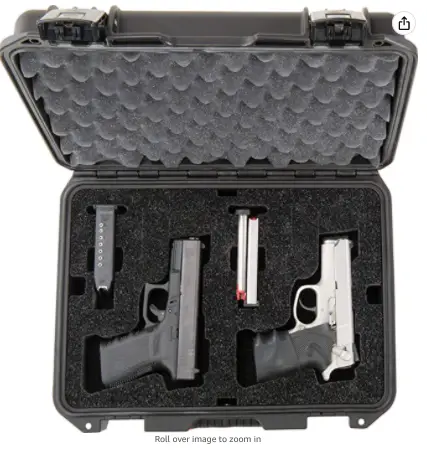
The TSA allows you to pack multiple guns into the same hard-sided case, however, this rule may differ depending on the airline with which you are flying.
It is recommended to pack your gun into a Pelican-style case with foam inserts cut to fit to best protect your gun, such as the extremely popular Pelican Storm iM2200 for handguns, or the Pelican 1720 long case for rifles. Below are a list of recommended lockable hard-shell cases that meet the TSA's criteria - the links will open in a new tab.
Popular TSA-Approved Gun Travel Cases for Flying with Handguns
Vault by Pelican V300 Hard Case
Case Club One-Pistol Heavy Duty Case
Case Club 3 Pistol Heav Duty Case
Popular TSA Approved Travel Cases for Flying with Rifles
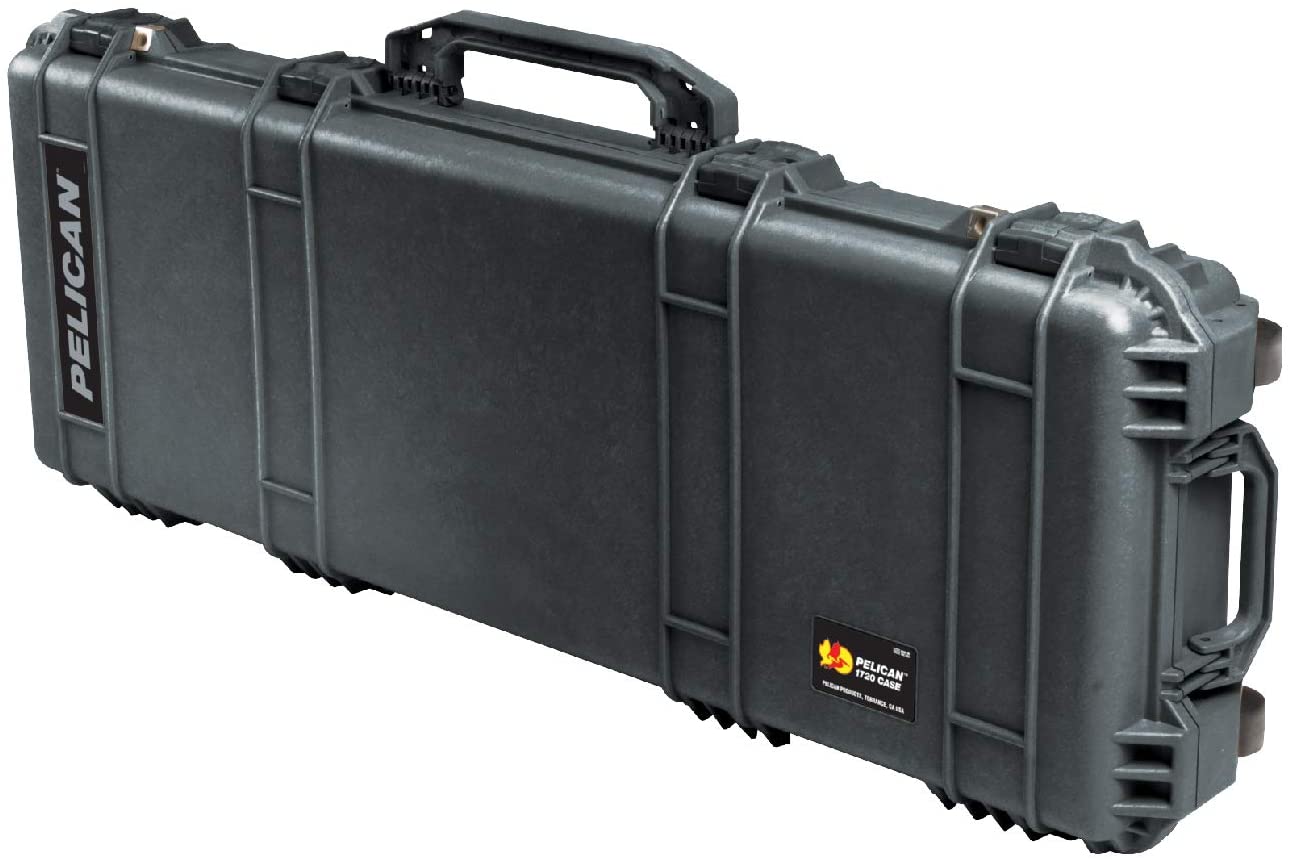
Cedar Mill Iron-Clasp Rifle Case
Cedar Mill Discreet Guitar Gun Case
Eylar Crushproof Tactical Rifle Roller Case
Remember that there is no need to visually identify the fact that the case is carrying firearms, and it is actually recommended that there be no signs that there is a firearm packed inside the case. Some people prefer to use a "decoy"-type carrying case, such as a Guitar Rifle Case or packing a soft rifle case inside a lockable Hard-sided Golf Case so as not to draw the attention of fellow passengers or baggage handlers to the fact that there is a firearm packed inside.
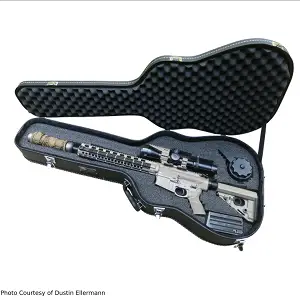
Do NOT Use a TSA Lock when Packing your Firearm
Your firearm's hard-sided case must be LOCKED when checking in - the locks may be either key or combination locks, it is up to you. Although now legally accepted, it is important and very recommend NOT TO USE A TSA-LOCK to lock your case. Only you should have the key to unlock your gun, and nobody else. TSA agents should never have access to your guns without you being present - a TSA Approved Lock can be opended by a TSA Master Key, allowing anybody with a TSA Master Key to unlock and access your gun when it is out of your hands, which opens up your firearm to potential tampering once it is out of your hands - once again, DO NOT USE A TSA LOCK when flying with your gun!
Only YOU, the passenger declaring the firearm, must have access to the key or combination to the lock, and you must keep the key with you at all times - do not leave the key in your other checked baggage, take it with you. Do NOT give your key or share your lock combination with any airline or TSA agent - you should be the only one to lock and unlock your case in all situations.
You will be asked to open the case for inspection by the check-in agent as well as TSA personnel - be sure that YOU are the one to unlock and relock the case after inspection. Do not give your key to the agent.
How Many Locks When Flying with a Gun?
Your gun case must be completely locked with as many locks as necessary, depending on the type of gun case and how many lock openings are accessible - If your rifle case has 4 lock holes, you will need to place 4 locks onto your case, otherwise your gun case will not be allowed to fly. Once again, ALL available lock holes on the case MUST be locked.
It is important there are a sufficient number of lockable holes on your gun case that it is impossible to access the contents of the case when it is locked. If all of the gun case's lock holes are locked, but it is still possible to force open the sides of the gun case and access it, your gun case will not be accepted for transport. It is important that your case cannot be easily pried open.
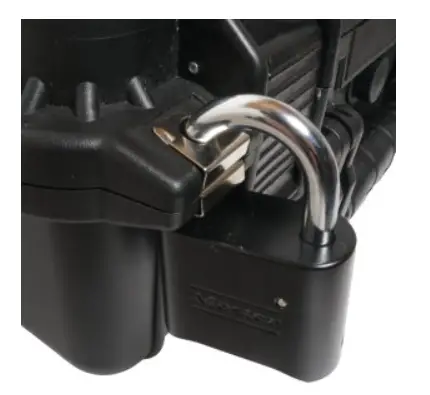
Packing Ammunition in Checked Baggage
Just like a firearm, ammunition is NOT ALLOWED in your carry-on - it may ONLY travel as checked baggage. The same applies for magazines, bolts, and firing pins - they are not allowed in your carry-on and must be packed in checked luggage, following specific packing rules for each of those items.
Ammunition must be stored in its ORIGINAL packaging / factory box, or in containers SPECIFICALLY designed for carrying small amounts of ammunition. You may NOT bring ammunition in an ammo bag.
Shotgun shells and ammunition .75 caliber or less can and should be packed in the same hard case as a firearm - once again, it must still first be packed in a small container specifically designed for carrying ammunition, then packed into the larger case. Your ammo must be packed only in CHECKED baggage, and cannot be brought through security or in your carry-on.
The TSA sets a strict limit of 11 lbs of ammunition per passenger per trip - as a rough guide, this is approximately 200 rounds of 9mm. A limit may also be set by your airline, in which case you may be restricted to bring less. The more restrictive of the rules is the one that applies.
It is important to understand that the TSA is VERY serious about loose ammunition in checked luggage - even if your ammunition is still in its original cardboard container packaging, with which you can legally fly, it is recommended to invest in a cheap lightweight, yet sturdy, ammo box to keep your ammunition organized in order to avoid the potential for the ammunition to fall out of the cardboard container and end up as loose ammunition in your luggage. If this happens, and your ammunition ends up loose within your gun case, you may face a serious issue with TSA and law-enforcement for not following the federal regulations for properly packing your firearm and ammunition, which may result in a $13,900 fine.
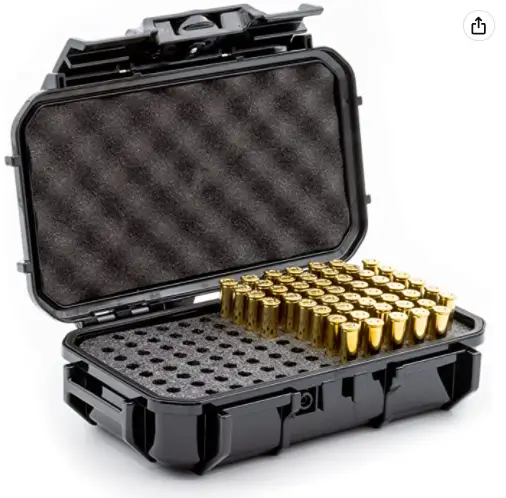
If flying with only ammunition and no gun, you cannot simply toss in your box of ammunition into your checked baggage. The ammunition must follow the same rules as a firearm, meaning that it must be packed in a HARD-SIDED, LOCKABLE storage case. We recommend something like the Evergreen 100 Round Bullet Locking Storage Case. The same steps for declaring your ammunition to the airline and TSA must be followed as for declaring you firearm.
Magazines, Clips, Firing Pins, Bolts, Holsters
Both Loaded and Empty magazines and clips must be stored the same way as guns and ammo - meaning in a locked, hard-sided case. To avoid the potential for any problems, it is recommended to unload all magazines as well, as some airlines have specific rules against bringing loaded magazines. Pack these into the same locked hard-sided carrying case as your gun that will be declared.
Firing pins and bolts may be packed together in your standard checked luggage or suitcase - they do not need to be in your gun case - but must never be brought in your carry-on or through security onto the plane.
Holsters, although theoretically allowed through the checkpoints and onto the plane, sometimes cause issues at security inspection checkpoints - we recommend packing holsters into your checked luggage or together with your firearm in the hard-sided case, in order to avoid any potentital problems or delays through the security screening process.
Steps to Checking-In and Declaring your Gun / Firearm At the Airport
Once you arrive at the airport with your gun packed in its locked hard-sided case, proceed directly to the check-in ticket counter - do NOT attempt to cross the TSA security inspection and to board the plane with your gun and/or ammo. You can skip wasting your time doing your check-in at a self-check kiosk, simply go directly to a customer service agent, as the steps required must be done in person with an airline representative.
At the check-in desk, you MUST declare to the airline agent that you will be flying with a firearm. Don't worry, you're not the first to be flying with a gun, it is completely normal, and the agent will not be shocked or surprised. The check-in agent from the airline will ask you to fill out and sign a Firearms Declaration Card which they will provide you with. You will be given a copy of your declaration which YOU ARE LEGALLY REQUIRED TO place into the locked hard-sided case which contains your gun.
It is VERY IMPORTANT to place the declaration card into the case with your firearm, as this proves and allows the TSA agent to know that you have properply declared your firearm to the airline - failure to do so may result in a fine of up to $13,900 for attempting to fly with an undeclared firearm, and you will be referred to local law enforcement.
When placing the declaration card in your case, it is important to be very clear when communicating with the airline agent as to exactly what you are doing throughout the process of unlocking and opening your case, as they may not be as comfortable around firearms as you are. Always confirm with the agent that it is okay for you to be handling your case. Under NO CIRCUMSTANCE should the airline represenative/check-in agent touch or handle your firearms. Be sure to securely re-lock the case after placing the declaration form inside.
If the check-in agent attempts to mark/identify your case from the outside as a firearm, STOP THEM from doing so. It is prohibited under federal law 18 USC Sec. 922 (e): "No common or contract carrier shall require or cause any label, tag, or other written notice to be placed on the outside of any package, luggage, or other container that such package, luggage, or other container contains a firearm.” It is best that no fellow passenger have any idea that any piece of luggage that may come out on the baggage carousel contains a firearm inside.
Having declared your firearm to the airline, and after paying any required checked baggage fees or special handling fees specific to your airline, you will NOT leave your firearm at the check-in desk together with the rest of your checked baggage - you will be asked to bring your firearm to the Oversized Baggage Drop area, where a TSA agent will scan your case, and potentially inspect it.
Be sure to follow the TSA officer's instructions, and when in doubt, do not hesitate to ask for clearer instructions before handling your case, locks, opening the case, or handling your firearms. Once again, you may be asked to unlock the case for closer inspection. Do NOT give your key to the TSA agent - only you should retain the key at all times.
Title 49: Transportation, Part 1540 – Civil Aviation Security: General Rules, Subpart B – Responsibilities of Passengers and Other Individuals and Persons, 1540.111 (c) (iv) – The container in which it is carried is locked, and only the passenger retains the key or combination.
Title 49: Transportation, Part 1544 – Aircraft Operator Security: Air Carriers and Commercial Operators, Subpart C – Operations, 1544.203 (f) (iii) The container in which it is carried is locked, and only the individual checking the baggage retains the key or combination.
You may give your key to the TSA agent to unlock your case themselves only if they IMMEDIATELY return the key to you, and the lock, key, and case are maintained within your sight at all times.
Be sure to be CLEAR when communicating with the TSA officer, and to always confirm any actions before taking them. Once you unlock the case, be sure to confirm with the agent before opening the case - do not reach for or touch your firearms unless specifically instructed to do so. The TSA agent will look to confirm that the firearm is unloaded. In some cases they may wish to handle your firearm for inspection - the TSA agent SHOULD NOT be handling your firearm, and may need to call for a law enforcement officer to do so on their behalf.
After inspection, be sure to completely lock the case again before your gun is sent along to the belly of the aircraft. After your gun is inspected and sent through the baggage system and you're ready to go - but don't go just yet. We recommend to wait around for about 15-20 minutes before crossing security and heading to your gate, just in case you get called up on the loud speaker to claim your firearm and to re-open it for another inspection - this way you won't have to leave the gate and go through the whole security process all over again in case the TSA would like to take a second look at your firearm.
Picking up Your Gun when Arriving at Your Destination
Upon arrival at your destination, your gun will most likely be brought out at the Oversized Baggage area in the baggage hall, although it has been known that sometimes they will come out on the regular checked baggage carousel - this all depends on the airport you are flying to, as well as the type of packaging used for your gun. When picking up your gun, be sure to be prepared with your baggage claim ticket and your photo ID - although not often, you may be asked to provide both when picking up your gun.
At some airports, firearms may be held in a secured area at arrivals, waiting for you to claim them - if your firearm does not come out on either the regular baggage carousel or at the Oversized Baggage carousel, simply find an airline representative to help you as your firearms case may be waiting for you in a secured airport office.
Additional Rules and Regulations for Flying with Firearms in the USA and Internationally
Be sure to know the exact rules and regulations regarding guns and firearms for your destination airport, as well any potential connecting airports. The above guide is for following the TSA (Transportation Safety Administration) rules, and not necessarily for your local destination. Even if your gun is legally checked in, you may encounter problems and be breaking the law at your destination airport by flying with your firearm, even if simply flying domestically.
If flying internationally, be sure to check the exact laws, rules, and regulations for your destination country. Keep in mind that BEFORE LEAVING THE USA with you firearm, you must have a US Customs Form 4457 signed by a US Customs official BEFORE YOU LEAVE. This will allow you to bring your firearms back into the country without further difficulty or having to pay duties on them.
Comments / Discussion / Questions
Let us know your personal experience or ask any questions here in the comments section below. You will need to login using your Emote or Google account. Be sure to upvote any helpful comments for other travellers preparing for their trip :-)
[AMZ asins='B07B7ZB484,B09FS5JJM3,B094WBMGRM,B0001HCBOU']